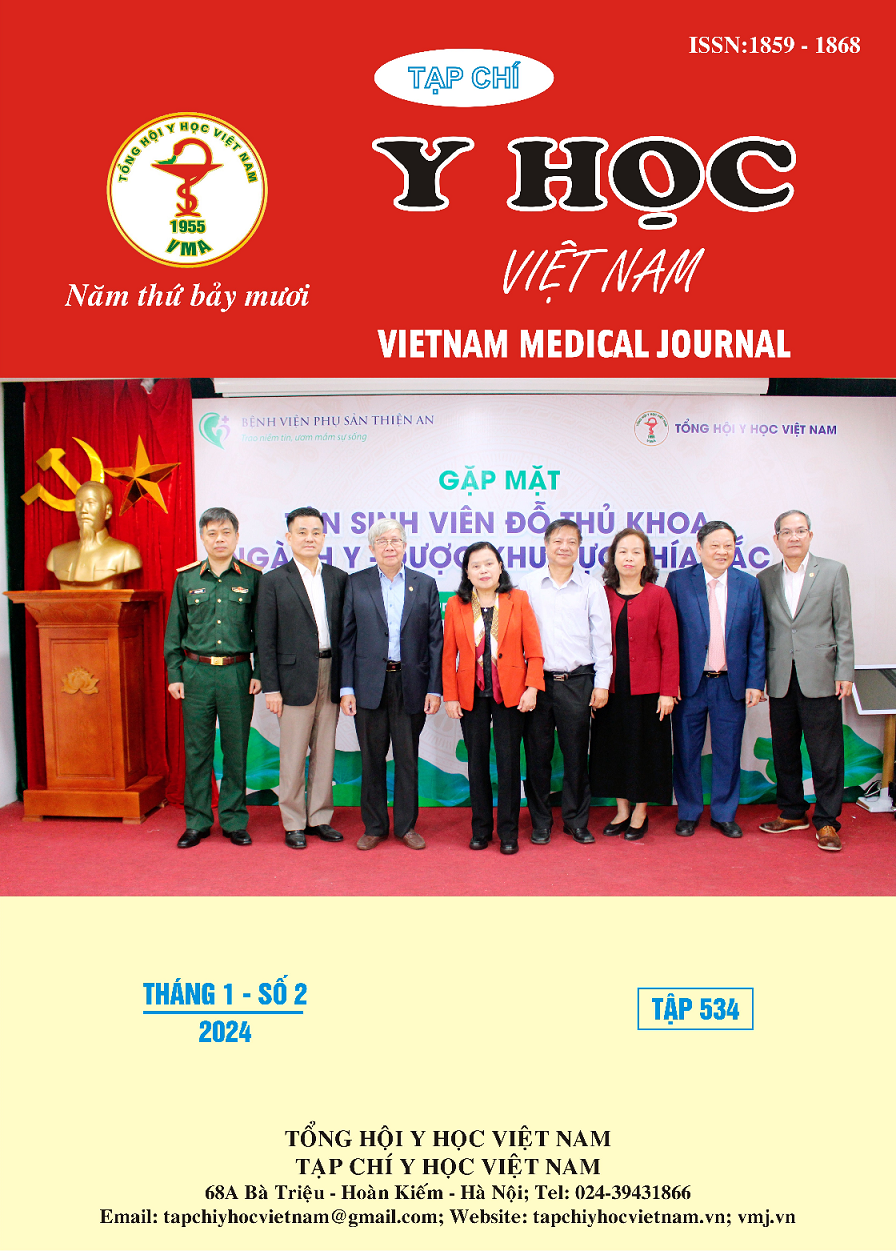CLINICAL AND SUB-CLINICAL CHARACTERISTICS AND RESULTS OF GENITAL WART TREATMENT IN PREGNANT WOMEN USING CO2 LASER
Main Article Content
Abstract
Objective: To survey the clinical and paraclinical characteristics and results in treating genital warts in pregnant women with CO2 Laser. Subjects and methods: prospective intervention, controlled comparison, convenience sample including 60 pregnant women and 60 women with genital warts coming for examination and treatment at the National Dermatology Hospital and agreed to participate. Research from September 2022 to July 2023. Treatment of genital warts with CO2 laser ablation. Monitor treatment results until damage is gone. Results: In the group of pregnant women with genital wart disease in the age group ≤ 29 (83.4%) and the main source of infection is from sexual partners (66.7%). Most of the distribution of genital warts is in the vulva (87.5%). The low-risk HPV group accounts for 22.5%, the high-risk HPV group accounts for 15.0%. The most common types are type 6 (10.8%), type 16 (7.5%), type 11 (6.7%), and type 8 (6.6%). There are also types such as 40, 57, 61,71,33,39, 82. In pregnant women, most mild and moderate injuries can be treated once (Mild: 64, 9% Average: 56.3%), not having to be treated 4 times. The level of severe damage was treated from the second time. The number of patients cured gradually decreased from the first time (58.9%), the second time (28.6%), the third time (8.9%), the 4th time (3.6%). The treatment failure rate is 6.7%. Conclusion: The data in this study provide important evidence about the distribution of genital warts in pregnant women, mainly in the vulva (87.0%) and vagina (53.3%). The rate of severe damage (11.6%) leads to a higher rate of treatment sessions (phase 4: 3.6%) compared to the group of non-pregnant women.
Article Details
References
2. Yanofsky VR, Patel RV, Goldenberg G. Genital warts: a comprehensive review. J Clin Aesthet Dermatol. 2012;5(6):25-36.
3. Gilson R, Nugent D, Werner RN, Ballesteros J, Ross J. 2019. IUSTI-Europe guideline for the management of anogenital warts. J Eur Acad Dermatol Venereol JEADV 2020;34(8):1644-1653. doi:doi:10.1111/ jdv. 16522
4. Lạc Thị Kim Ngân, Đào Hoàng Thiên Kim, Nguyễn Thị Thuỳ Trang, Huỳnh Văn Bá, Nguyễn Văn Lâm. Đặc Điểm Lâm Sàng Và Týp Human Papillomavirus Ở Bệnh Nhân Sùi Mào Gà Tại Bệnh Viện Da Liễu Thành Phố Cần Thơ Năm 2020. Accessed August 27, 2023. https://tapchi. ctump.edu.vn/index.php/ctump/article/view/809/672
5. Hà Nguyên Phương Anh (2015). Nhiễm Human Papillomavirus trên bệnh nhân bịnhiễm trùng lây truyền qua đường tình dục và tác dụng của cimetidin trong phòng tái phát bệnh sùi mào gà. Luận án Tiến sĩ y học, Trường Đại học Y Hà Nội.
6. Thông tư 35/2016/TT-BYT danh mục tỷ lệ điều kiện thanh toán dịch vụ kỹ thuật y tế người tham gia bảo hiểm mới nhất. Accessed October 2, 2023. https://thuvienphapluat.vn/van-ban/Bao-hiem/Thong-tu-35-2016-TT-BYT-danh-muc-ty-le-dieu-kien-thanh-toan-dich-vu-ky-thuat-y-te-nguoi-tham-gia-bao-hiem-288918.aspx
7. Calkins JW, Masterson BJ, Magrina JF, Capen CV. Management of condylomata acuminata with the carbon dioxide laser. Obstet Gynecol. 1982;59(1):105-108.
8. Flores-Luna L, Bravo MM, Kasamatsu E, et al. Risk factors for gastric precancerous and cancers lesions in Latin American counties with difference gastric cancer risk. Cancer Epidemiol. 2020;64: 101630. doi: 10.1016/ j.canep.2019. 101630
9. Sugai S, Nishijima K, Enomoto T. Management of Condyloma Acuminata in Pregnancy: A Review. Sexually Transmitted Diseases. 2021;48(6):403-409. doi:10.1097 /OLQ .00000 00 000001322
10. Cohen E, Levy A, Holcberg G, Wiznitzer A, Mazor M, Sheiner E. Perinatal outcomes in condyloma acuminata pregnancies. Arch Gynecol Obstet. 2011;283(6): 1269-1273. doi: 10.1007/ s00404-010-1558-2


